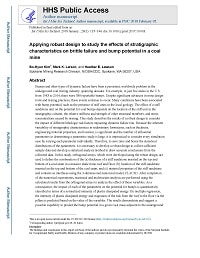Mining Publication: Applying Robust Design to Study the Effects of Stratigraphic Characteristics on Brittle Failure and Bump Potential in a Coal Mine
Original creation date: January 2018
Authors: B Kim, M Larson, H Lawson
Bumps and other types of dynamic failure have been a persistent, worldwide problem in the underground coal mining industry, spanning decades. For example, in just five states in the U.S. from 1983 to 2014, there were 388 reportable bumps. Despite significant advances in mine design tools and mining practices, these events continue to occur. Many conditions have been associated with bump potential, such as the presence of stiff units in the local geology. The effect of a stiff sandstone unit on the potential for coal bumps depends on the location of the stiff unit in the stratigraphic column, the relative stiffness and strength of other structural members, and stress concentrations caused by mining. This study describes the results of a robust design to consider the impact of different lithologic risk factors impacting dynamic failure risk. Because the inherent variability of stratigraphic characteristics in sedimentary formations, such as thickness, engineering material properties, and location, is significant and the number of influential parameters in determining a parametric study is large, it is impractical to consider every simulation case by varying each parameter individually. Therefore, to save time and honor the statistical distributions of the parameters, it is necessary to develop a robust design to collect sufficient sample data and develop a statistical analysis method to draw accurate conclusions from the collected data. In this study, orthogonal arrays, which were developed using the robust design, are used to define the combination of the (a) thickness of a stiff sandstone inserted on the top and bottom of a coal seam in a massive shale mine roof and floor, (b) location of the stiff sandstone inserted on the top and bottom of the coal seam, and (c) material properties of the stiff sandstone and contacts as interfaces using the 3-dimensional numerical model, FLAC3D. After completion of the numerical experiments, statistical and multivariate analysis are performed using the calculated results from the orthogonal arrays to analyze the effect of these variables. As a consequence, the impact of each of the parameters on the potential for bumps is quantitatively classified in terms of a normalized intensity of plastic dissipated energy. By multiple regression, the intensity of plastic dissipated energy and migration of the risk from the roof to the floor via the pillars is predicted based on the value of the variables. The results demonstrate and suggest a possible capability to predict the bump potential in a given rock mass adjacent to the underground excavations and pillars. Assessing the risk of bumps is important to preventing fatalities and injuries resulting from bumps.

- Coal Bumps and Odd Dynamic Phenomena - A Numerical Investigation
- Development of Guidelines for the Design of Support Systems to Manage Coal Mine Rib Hazards
- Elastic and Shear Moduli of Coal Measure Rocks Derived from Basic Well Logs Using Fractal Statistics and Radial Basis Functions
- A Hybrid Statistical-Analytical Method for assessing Violent Failure in U.S. Coal Mines
- Identification of Areas at Risk for Coal Bursts in Deep Cover Room and Pillar Mines
- Measuring Mining Safety with Injury Statistics: Lost workdays as Indicators of Risk
- Multiple-Seam Mining in the United States: Background
- Portable XRF Analysis of Occupational Air Filter Samples from Different Workplaces Using Different Samplers: Final Results, Summary and Conclusions
- Practical Risk Assessment Guidelines for Identifying, Assessing, and Mitigating Stored Energy Hazards in Underground Coal Mines During and After a Mine Emergency
- Spontaneous Combustion